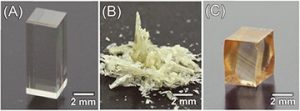Under the cover of darkness, a well-known brittle semiconductor turns out to be surprisingly flexible. Scientists at a Japanese university have investigated the previously unknown ability of zinc sulfide crystals to resist deformation under irradiation by light and to bend when the light goes out (Science, doi:10.1126/science.aar6035).
Illumination experiments
Inorganic semiconductors play an important role in electronic components, of course, but their brittleness limits how they can be shaped. Zinc sulfide, in particular, has several interesting uses in optics, from infrared-transparent lenses and windows to electroluminescent products, thanks to its bandgap in the range of 3.6–3.7 eV.
Three researchers at Nagoya University in Japan subjected crystals of zinc sulfide to a battery of deformation tests at room temperature and under varying levels of illumination: white light, ultraviolet light and complete darkness. As expected, the crystals fractured easily in the light. In the dark, however, the semiconductor material deformed relatively easily, up to a strain of 45 percent.
The pure zinc sulfide crystals started out colorless and transparent, but the samples that were deformed in darkness acquired an orange tint proportional to the amount of strain. That effect shows that the optical bandgap of the material decreases with greater deformation, according to the researchers.

Zinc sulfide (ZnS) crystals (A) show catastrophic fracture after mechanical tests under ordinary light-exposure environments (B). However, ZnS crystals can be plastically deformed up to a strain of 45 percent in complete darkness even at room temperature (C). Moreover, the optical band gap of the deformed ZnS crystals decreased by 0.6 eV after deformation, resulting in an orange tint.
Explaining discoloration
Nagoya associate professor Atsutomo Nakamura says he initially had trouble understanding the macroscopic color change of the semiconductor crystals. “Although dislocations are multiplied by deformation, the volume fraction of dislocations in a crystal is very, very low”—less than 10–5, he says. He used results from first-principles calculations to understand how dislocations within the crystal structure can affect the color of the whole crystal.
The transition between brittleness in light and flexibility in darkness is basically reversible—except, of course, when the material has finally broken. The change from flexible to brittle is fast, according to Nakamura, while the change from flexible to brittle seems to be slow, at least for zinc sulfide. The latter transition depends on the type of material because the lifetime of the excited electrons or holes would affect the speed of the change. Quantifying the rate of change for zinc sulfide and various other inorganic semiconductors still remains to be done, but Nakamura believes that the timescale will be short enough for a practical switch.
One of the challenges the Nagoya team had to overcome was simply measuring the deformation of their illuminated samples—once a crystal breaks, the internal stress is relieved. According to Nakamura, the researchers had to stop the experiments just before the fracturing and then observe the crystals’ internal structure with transmission electron microscopy.

No Comment
You can post first response comment.